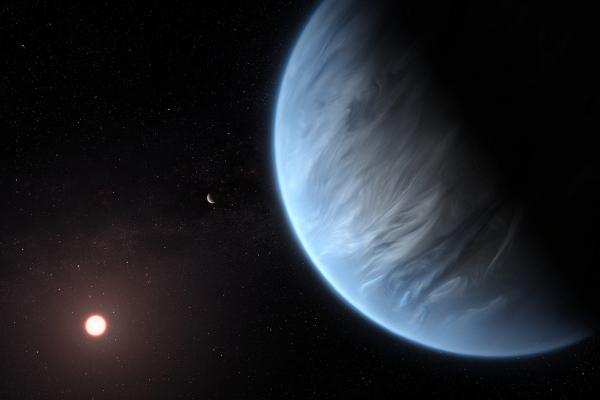Atmospheric water has been discovered by European scientists on a planet 124 light-years away from us. It is possible that clouds form and even rain falls on this faraway world, dubbed K2-18 b. The planet lies within what astronomers call the habitable zone, with a temperature that could allow life to thrive there.The rocky planet is eight times the mass of Earth and known as a super-Earth. This is the name given to planets between the size of Earth and Neptune. ‘Super-Earths are actually the most common type of planet in our galaxy,’ said Dr Ingo Waldmann, extrasolar planet explorer at University College London, UK, one of the scientistswho reported on the existence of the watery world K2-18 b. Super-Earths are also possible residences of alien life.The first planet orbiting an active star beyond our own solar system was discovered in 1995. Since then, the Kepler space telescope has increased the rate of discovery, with 4,000 such exoplanets now known. Initially, large gaseous giants near their stars, ‘hot Jupiters,’ seemed most common, but as more and more super-Earths piled up, scientists became puzzled by their abundance.‘The early exoplanet systems found were the simple ones, with one hot Jupiter going around a star. We weren’t really expecting anything like super-Earths, but then they started to show up,’ said Dr Waldmann. ‘We know as good as nothing about super-Earths at the moment, because they don’t exist in our own solar system.’Before NASA’s Kepler space telescope, most exoplanets were thought to be gas giants and hot Jupiters. After the nine-year mission, the majority of exoplanets now known are actually rocky planets with a size ranging from Earth to Neptune. Image credit – NASA/Ames Research Center/Natalie Batalha/Wendy StenzelDiverseMost of these mysterious planets are discovered when they transit in front of small stars and cause the starlight to dim. From this, researchers can work out the mass and the radius of the planet and the evidence suggests that these worlds are incredibly diverse in their make-up.‘Super-Earths can be all sorts of things really,’ said Dr Waldmann. He gives the example of 55 Cancri e, a planet with a lava ocean at temperatures hot enough to melt iron, and Gliese 1214 b, which is a potential ocean planet consisting mostly of water. Scientists deduce which molecules are in a planet’s atmosphere by studying starlight as it passes through.Knowing what goes on inside these distant planets is far more difficult. ‘We can look at the surface of the star to get hints about the chemistry and composition of a planet, which gives us hints as to how much iron or silicon may be in a planet,’ said Dr Razvan Caracas, planetary mineralogist at École Normale Supérieure de Lyon in France.This is important because depending on whether there is a solid core, perhaps made from nickel or nickel and iron, and a liquid metal outer core, a planet might or might not have a magnetic field. Earth’s magnetic field keeps most of the sun’s radiation away from us by deflecting a stream of charged particles so they don’t reach our planet’s surface. Researchers believe this sort of shielding would be necessary for life to emerge elsewhere.Dr Caracas supervised a project calledABISSEwhich ran computer simulations of various iron-nickel mixtures at extremely high pressures to see how they behaved. These are the metals that likely sit at the core of super-Earths, but it is unclear whether iron and nickel would mix together, separate into different layers or become liquid at the intense pressures inside large planets.“‘Two cores might behave differently, and one might have a magnetic field and the other wouldn’t.’Dr Razvan Caracas, École Normale Supérieure de Lyon, FranceBy understanding the type of core structure that could arise from proportions of nickel and iron, scientists hope to understand what could be happening inside super-Earths based on what we find out about their chemical composition.Protection‘Two cores might behave differently, and one might have a magnetic field and the other wouldn’t,’ explained Dr Caracas. ‘A stronger magnetic field gives you better protection on the surface from the sun’s rays, and that means you can make organic molecules that are more complex.’Dr Guillaume Fiquet, an experimental physicist at CNRS and Sorbonne University in Paris, France, is also trying to understand super-Earth interiors through a project calledPLANETDIVE. ‘When people talk about the habitability of planets, this is often related to the presence of a magnetic field, which itself is related to having some kind of metallic core or at least conductive material (in vigorous motion),’ he said.He is investigating how materials like iron behave under pressures inside super-Earths, which could be up to 1 terapascal, three times the pressure within Earth. This squashes atoms together and can change the properties of materials, meaning that our knowledge about how they behave on Earth may not apply to exoplanets.‘Exoplanets can be larger planets than Earth, which means the pressures and temperatures could be much greater,’ Dr Fiquet said, ‘That forces us to try to develop new tools to access special states of matter that we don’t know yet.’Dr Fiquet sheds light on this mystery by recreating the high temperatures and extreme pressures that may lie at the heart of these exotic planets. He does this on vanishingly small scales, firing powerful lasers at tiny specs of metal or squeezing them between microscopic diamond anvils.This experimental setup has helped him draw melting curves for elements like iron that probably sit at the core of super-Earths under intense pressure. These can then be used to refine the material properties that scientists use to infer what goes on in the interiors of super-Earths and ultimately know more about their bulk chemical composition, says Dr Fiquet.Meanwhile, Dr Waldmann leads research to assist astronomers in dealing with super-Earth data from future exoplanet discoveries using artificial intelligence (AI). We need AI, said Dr Waldmann, ‘because all this data is extremely difficult to analyse and we will be stretched to the limit of what is possible to do by hand.’Super-Earths are prime candidates for the existence of extraterrestrial life. His AI, developed through theExoAIproject, will help astronomers interpret observations of chemicals in an exoplanet’s atmosphere, for example, and tell them whether a super-Earth is interesting for further study or not.‘That is the holy grail,’ Dr Waldmann added. ‘Finding chemical signatures in the atmosphere of a super-Earth due to life. Hopefully we will in the next couple of years, or decades.’The research in this article was funded by the EU. If you liked this article, please consider sharing it on social media.
This article was originally published in Horizon, the EU Research and Innovation magazine.
Add to favorites:
Share:
Listing Description
Video
Documents
No documents available.
Ask KETMarket to make a contact
Connect with the Listing Owner!
💬 Please log in now to askKETMarket to make a contact. Not a member yet? Sign up for free and start connecting today!
Video
Related Funding and Finance Opportunities
Unlock Exclusive Funding Opportunities!
🔑 Get instant access to tailored funding opportunities that perfectly match your needs. This powerful feature is exclusively available to our premium members—helping you save time, stay ahead of the competition, and secure the right funding faster.
Upgrade to Premium now and never miss an important opportunity again! Already a premium member? Log in here to explore your matches.
Related Innovation Offers
Discover Tailored Innovation Offers!
🚀 Gain access to technology solutions that match your specific needs and interests—carefully selected to support your innovation goals. These offers are exclusively available to our premium members, helping you identify relevant technologies faster and start the right conversations with potential partners.
Upgrade to Premium now and explore your personalized technology matches today! Already a premium member? Log in here to view your tailored offers.
Related Knowledgeable Resources
Discover More with Premium: Related Knowledge Resources
🔒 You’re missing out on expert-curated knowledge specifically matched to this topic. As a Premium member, you gain exclusive access to in-depth articles, guides, and insights that help you make smarter decisions, faster.
Whether you’re preparing a funding proposal, researching a new market, or just need reliable information—our Premium knowledge matches save you hours of research and point you directly to what matters.
Upgrade to Premium now and instantly unlock relevant knowledge tailored to your needs! Already a member? Log in here to view your personalized content.

